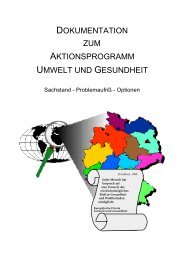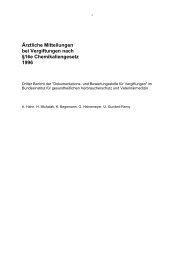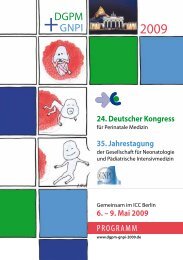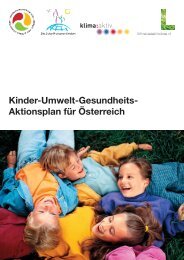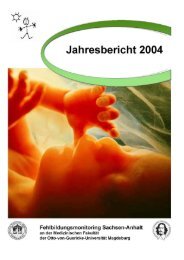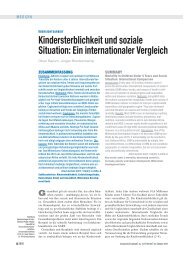Wiener Gesundheits- und Sozialsurvey Vienna Health and Social ...
Wiener Gesundheits- und Sozialsurvey Vienna Health and Social ...
Wiener Gesundheits- und Sozialsurvey Vienna Health and Social ...
Sie wollen auch ein ePaper? Erhöhen Sie die Reichweite Ihrer Titel.
YUMPU macht aus Druck-PDFs automatisch weboptimierte ePaper, die Google liebt.
SUMMARY AND CONCLUSIONS<br />
women <strong>and</strong> 14 percent of men experience restrictions.<br />
These numbers increase with age <strong>and</strong> are highest in the<br />
age group above 75, where one in five men <strong>and</strong> one in<br />
four women are affected. The number of people suffering<br />
chronic restrictions increases drastically with age, from<br />
17 percent among the youngest to 75 percent among the<br />
oldest.<br />
Dental health is strongly influenced by the age factor.<br />
Loss of teeth increases drastically with age; one in two<br />
women <strong>and</strong> 39 percent of men in the age group above 75<br />
do not have any of their own teeth left. This is less apparent<br />
among people of higher education <strong>and</strong> in better positions.<br />
The indicator ADL was used to calculate a person´s ability<br />
to carry out simple activities of daily living in the<br />
age group above 60. The poorest results were fo<strong>und</strong> at<br />
the lowest educational level for both men <strong>and</strong> women,<br />
while between the other levels there were hardly any differences.<br />
Men seemed to fair better than women<br />
throughout. The higher a person’s income or position at<br />
work, the better their ability to carry out activities of daily<br />
living.<br />
40<br />
Priority Measures<br />
<strong>Social</strong> <strong>and</strong> individual health conditions were analysed<br />
with the help of complex models, eliminating the factors<br />
age, education <strong>and</strong> income. People’s subjective state of<br />
health was fo<strong>und</strong> to have the most conspicuous positive<br />
correlation with their subjective quality of life, as well as<br />
their level of physical activity. Life events <strong>and</strong> a high<br />
body mass index, on the other h<strong>and</strong>, have a strong negative<br />
bearing on a person’s subjective state of health. Satisfaction<br />
at work was fo<strong>und</strong> to be a positive factor for<br />
women, while according to current data it had little influence<br />
on men’s subjective state of health.<br />
Men <strong>and</strong> women who suffer from a chronic disease are<br />
often fo<strong>und</strong> to have experienced a number of life events<br />
in the past. Life events experienced during childhood are<br />
the only other factor that increases a person’s proneness<br />
to diseases later on in life. There is a strong negative correlation<br />
between chronic diseases <strong>and</strong> subjective quality<br />
of life, particularly among women. The causality is not<br />
clearly defined here, i.e. it is not evident whether diseases<br />
influence the quality of life, or whether low quality of life<br />
favours the development of diseases. None of the behavioural<br />
factors examined were in any way related to the<br />
occurrence of chronic diseases.<br />
● Promote health at all political levels<br />
● Strengthen people’s self-confidence <strong>and</strong> their capacity to act at all age levels<br />
● Offer health services tailored to different target groups <strong>and</strong> social levels<br />
● Make use of unused health potentials to avoid cardiovascular diseases <strong>and</strong> diseases of the locomotor system<br />
● Enhance health promotion infrastructure<br />
● Avoid accidents among older people, during adolescence <strong>and</strong> during sports activities<br />
● Recognize diseases at an early stage, provide targeted therapy (particularly for cardiovascular diseases,<br />
diseases of the locomotor system <strong>and</strong> diabetes) alleviate disabilities <strong>and</strong> improve the individual quality of<br />
life<br />
● Offer age- <strong>and</strong> gender-specific health programmes as well as targeted programmes for different social<br />
groups<br />
● Promote physical, mental, social <strong>and</strong> economic independence<br />
● Establish measures to avoid poverty<br />
WIENER GESUNDHEITS- UND SOZIALSURVEY




